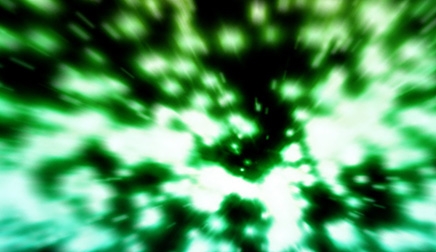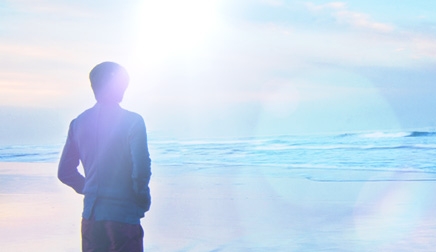 Home > Nature of light > The basic nature of light
Home > Nature of light > The basic nature of light
The basic nature of light

Light is intimately involved with our daily lives. Many unique properties of light are extremely fascinating.
Here, we will take one step closer to the wonders of light through its well-known basic properties.
Is Light a wave or a particle?
Light travels at a speed of 300,000 kilometers per second
Is Light a wave or a particle?
Light has the properties of a wave and a particle.
The word “wavelength” is used to express the wave or undulating property of light. It is the distance that light travels in one oscillation, and is often expressed using a unit called "nanometer". One nanometer is equal to one billionth of a meter. Our eyes can only see light that is of a wavelength between approximately 400 to 700 nanometers. This range is called the visible light. The light of other wavelengths includes X-rays, ultraviolet rays, and infrared rays. Though we cannot see them directly, these are also members of the light family.
On the other hand, light also has the property of a particle. The intensity of the light varies depending on the number of particles. Bright light has many particles while dark light has fewer particles. These particles of light are called “photons”.
We can check out the particle property of light by comparing light with sound using a device called oscilloscope. Sound is known to have the characteristics of a wave. When the intensity or magnitude of sound gradually weakens, the signal of sound becomes smaller and eventually disappears. However, when light gradually weakens, the overall quantity of its signal becomes less yet the few remaining pulses (extremely short signals) can be detected and the size of these individual signals does not decrease. This tells us that light cannot become any smaller, and that light has a property of a “particle.”
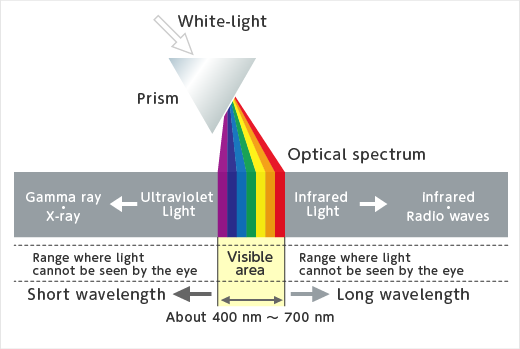
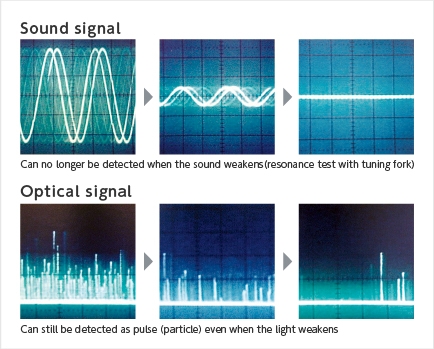
Light travels at a speed of 300,000 kilometers per second
Light travels at a speed of about 300,000 kilometers per second. Surprisingly, light can travel around the earth 7.5 times in a mere one second. This property of light is utilized in many technical applications such as optical communications which transfer huge data in a very short time. However, even light, which is faster than anything known to man, can move only 0.3 millimeters in a trillionth of a second (a picosecond – see note) in a vacuum. In recent years, research of such optical phenomenon that occur in these unbelievably short period of time, is becoming essential in new research fields of physics, chemistry, biology, and others.
Note: 1 millisecond = 1 thousandth of a second, 1 microsecond = 1 millionth of a second, 1 nanosecond = 1 billionth of a second, 1 picosecond = 1 trillionth of a second.

per second.
Interaction of light with matter

comes in contact with something.
When in a vacuum such as outer space where no matter is present, light travels straightforward. However, light behaves in a variety of ways when it comes in contact with water, air, and other matters – it is "absorbed", "transmitted through", "reflected", and "scattered". When light strikes matter, a part of that light is absorbed into the matter (a) and is transformed into heat energy. If the matter that the light strikes is a transparent material, the light component that was not absorbed within the material is “transmitted” through (b) and exits to the outer side of the material. If the surface of the material is smooth (a mirror for example), “reflection” occurs (b), but if the surface is irregular having pits and protrusions, the light “scatters” (c).
The “transmitted,” “reflected,” or “scattered” light allows our eyes to see the colors and shapes of objects.
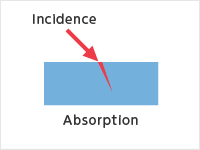
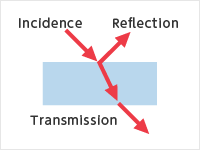
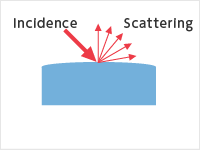
Light “reflects”
Why is a distant mountain sometimes seen clearly reflected on the surface of a lake or pond?
The sunlight striking a mountain bounces back in many directions. This is called reflected light. Our eyes see the mountain by capturing some of the light reflected from the mountain which directly reaches our eyes and then by forming an image of the reflected light on the retina through the lens of the eye. (Pink lines in the figure below represent the reflected light. To make it easier to describe, this figure shows a boy looking at a distant tree instead of a mountain.)
When there is a lake or pond between our eyes and a mountain, the light arriving there from the mountain reflects off the surface of the lake or pond (blue dotted lines in the figure). If the surface is calm with no wind and also flat and smooth such as on level surfaces with no irregularities like mirrors and glass, then the angle of the incident light (angle of incidence) and the angle of the light bouncing off the surface (angle of reflection) are equal to each other. This is referred to as specular reflection or mirror reflection. When the surface is located in an ideal location where the light bouncing off the surface by means of specular reflection directly reaches our eyes, then we can see a sharp, clear image of the mountain reflected on the surface.
On the other hand, if the surface is rough or irregular, then the direction of the reflected light varies depending on the position on the surface, resulting in a distorted image of the mountain reflecting on the water surface.
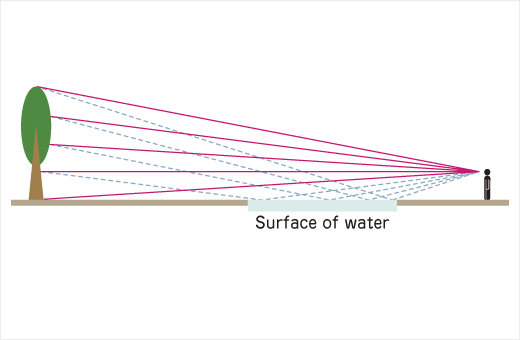

surface of a rice field filled with water.
Photo courtesy of IWATE NIPPO CO., LTD.
From “Photo News” of “IWATE NIPPO”
issued on May 20, 2017
Light “scatters”
Why is it that on a clear day, the color of sky is blue but appears red in the evening?
Light from the sun reaches the earth after traveling through space, it “scatters” when striking the various particles and molecules in the atmosphere. A part of this light returns to the outer space and the remainder of the light reaches the surface of the earth after traveling through the atmosphere. The level of scattering of light depends on its wavelength, and of the lights that our eyes can see, blue light is more intensely dispersed or scattered. This is why the sky appears blue to our eyes during the day.
On the other hand, during sunrise and sunset, the sky can appear orange, pink, or red to our eyes. This is because when the position of the sun is lower, the distance that the light travels through the atmosphere becomes longer, and the blue light that is gradually scattered and weakens. Therefore, the remaining red or orange light reaches our eyes.


Light “refracts”
When you look into a straw placed in a glass, the portion of the straw inside the water appears bent. Why is that so?
Light “refracts” at the boundary between air and water in the glass. Refraction occurs because light travels at different speed in air and water. Our eyes catch the scattered light from the straw in the water, but refraction occurs when the light in the water enters the air. However, the light coming out from water appears to be moving straightforward to our eyes, and our eyes form a “virtual image” on the line extending from the refracted light. Thus the tip of the straw in the water appears to have deviated from its actual position.
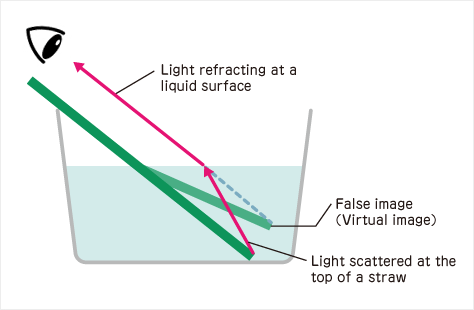

Light “interferes”
How are those intriguing colors of blowing soap bubbles made?
Light moves in various directions so the light waves are constantly striking against each another. The phenomenon that occurs when the light waves collide with each other is called “interference.”
When the peaks of these waves overlap, the peaks become even larger. When the peaks and valleys of the waves collide, the waves cancel each other out. This interference is what causes us to see the various colors in soap bubbles.
A soap bubble is made of an extremely thin film. Light reflecting from the outer and inner sides of this film interferes with each other to cause the colors that we see. Moreover, the viewing angle of the light interference occurring at the soap bubble film changes due to the ceaseless movement of the soup bubble.
Due to the waves of light repeatedly intensifying and canceling each other out, our eyes see mysterious and constantly changing colors.

Light “disperses”
Why does rainbow appear in the sky after it rains?
The light from the sun is called white light beam, but it actually is a mixture of different colored lights which appear white to our eyes. Using a prism to separate the white light beam allows us to see the various colors of light.
This phenomenon is called “dispersion” of light. In the natural world, water droplets act like a prism then they remain in the air after the rain.
Light that strikes water droplets refracts and moves to the interior of the droplet, reflects within the droplet, and refracts when exiting the droplet. The water droplets in the air act just like a prism causing dispersion and the light reaching our eyes appears as continuous bands of different colors. That is what makes a rainbow.
If we look closely around the rainbow, we may sometimes see another rainbow (a secondary rainbow) whose color sequence is reversed, on the outer side of the first rainbow. This secondary rainbow appears due to light that reaches our eyes reflecting twice in the water droplet.


Mr. TOYODA

Mr. OHSUKA



